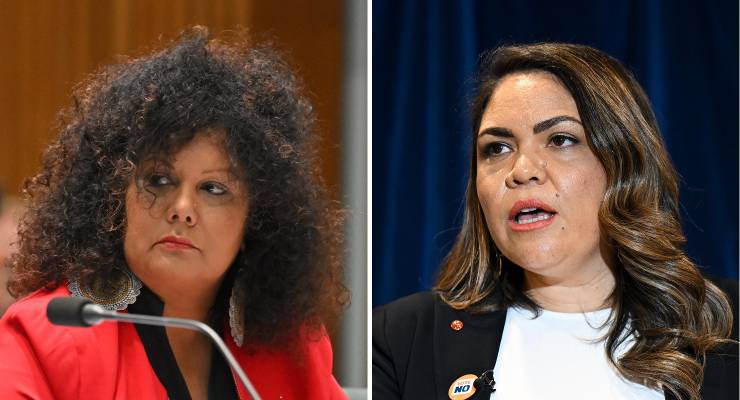
Australian Electoral Commission (AEC) tally room data from the 2022 federal election indicates that remote Indigenous communities in the Northern Territory voted overwhelmingly for Labor Senator Malarndirri McCarthy over Country Liberal Party (CLP) Senator Jacinta Nampijinpa Price.
The numbers challenge comments made by prominent No advocate Price that she is a “vessel” and voice for Indigenous people in federal politics.
Crikey analysis — with the assistance of Poll Bludger election analyst William Bowe — looked at data from the “NT first preferences by polling place” vote for “Remote Mobile Teams” and found the Labor ticket headed by McCarthy outpolled the CLP ticket headed by Price 50.4% to 28.1%. For all other booths in the territory (excluding postal and absent votes) the Labor ticket trailed the CLP ticket 31.3% to 35.9%, making the remote Labor vote 19.1% higher and the CLP vote 7.8% lower than everywhere else.
Price and McCarthy were elected as NT senators in 2022 with 36,195 and 34,540 votes respectively.
In response to the figures, McCarthy told Crikey that all Australians “from the city to the regions and the bush” deserve to have their voice heard in federal Parliament and that her role was to represent the territory: “I am committed to representing all Territorians in the Senate as well as the people of Christmas and Cocos Keeling Islands, regardless of how they wish to vote.”
Price did not respond to Crikey’s requests for comment.
Bowe told Crikey that the McCarthy-Price Senate split of Indigenous to non-Indigenous votes was less about the two individuals and more about party preferences among Indigenous people in the NT.
“This shouldn’t be seen as specific to Price. Labor owes its tenuous hold in Lingiari to Indigenous voters,” he said, adding that the CLP vote predominantly came from pastoral (and non-Indigenous) parts of the territory.

A spokesperson for AEC NT told Crikey that although it does not collect voter ethnicity (including Indigeneity) during enrolment or casting of votes, any votes collected from an Indigenous community as part of its remote voter service “can be assumed to have come from a demographic of majority Indigenous voters”.
It confirmed that analysis of its 16 remote mobile team results would give the “closest idea of the Indigenous vote for each senator”.
Crikey cross-checked the locations of remote voter services in the May 2022 federal location with 2021 census data to ensure the representative populations were majority Indigenous.
Of the 189 remote locations listed, 159 (84%) had majority Indigenous populations and 132 (70%) were over 75% Indigenous. More generally, census data showed these remote locations had a combined population of 48,392 people, of whom 34,002 (70%) were Indigenous.
The numbers come with caveats including limitations on the accuracy of Indigenous census data and remote mobile team locations. The AEC said that the places listed on its website indicate where it intended to go, but not necessarily where it did go due to issues with community access, bad weather, and vehicle breakdowns: “These locations get advertised in advance, but if there are changes the morning of, which are common, we take more of a local comms approach. Our priority is to alert the communities rather than update the website.”
Common AEC practice post-election or referendum is to remove the locations of these remote voter services from its website in the interests of protecting voter privacy — some communities have as few as 10 enrolled voters — but despite last-minute shuffles, the AEC told Crikey the previously published data remains the best resource for the areas serviced by remote mobile teams.








The empty variety, which as we all know, makes the most noise.
Sez a kettle.
Congrats. for winning this week’s no doubt unsought ‘BegsQuestion’ award with the no doubt unconscious example – extra points for double twist pike in making a rhetorical aside into an unassailable strawoman to attempt to burn.
As the Molehill said to the failed Mountaineer.
So would we be justified in thinking that McCarthy owes her Senate spot to Aboriginals, Price owes her Senate spot to Non-Indigenous?……….
…..not quite what Price would have you believe.
But on a par with her other bullshit.
Would be interesting, but has any media actually interviewed the 2021 CLP Senate preselection candidates’ for their up close insights into that whole process, and now on The Voice?
https://www.abc.net.au/news/2021-06-26/jacinta-price-wins-clp-preselection-battle/100245740
The CLP version of Marjorie Taylor Greene…………….
What good investigative work Crikey and William Bowe. This assertion made by Jacinta Nampijinpa Price that she represents Indigenous territorians is now thoroughly debunked. This goes to the heart of her credibility in relation to her criticism of the Uluru statement.
Without going into electoral analysis I think it’s pretty clear who Price represents every time she opens her mouth. And if that doesn’t answer you look at who’s nodding approvingly at her.
In my mind, I find Price delusional, amongst other things
It’s certain that your mind weighs heavily on Sen. Price.
With that & $7 she could get a cup of coffee.